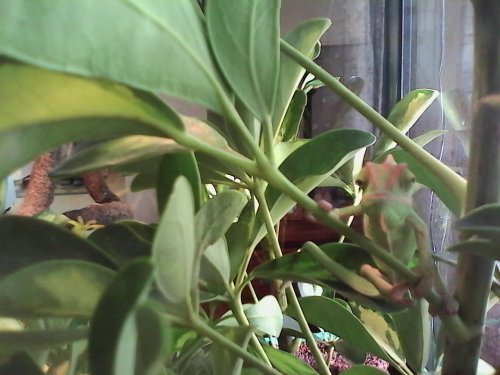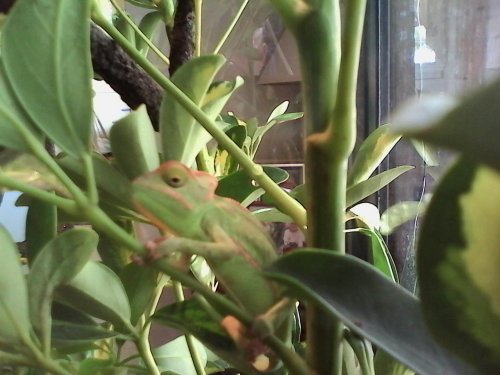Chameleon Info:
Name-Flash, Veiled- Driskel Bloodline
◦ Your Chameleon - The species, sex, and age of your chameleon. How long has it been in your care?
Male approx 3 months, 1 week
◦ Handling - How often do you handle your chameleon?
Twice, removing him from shipping container, a few days later
◦ Feeding - What are you feeding your cham? What amount? What is the schedule? How are you gut-loading your feeders?
Pinhead crickets, Pro Gutload in the late morning after he has warmed up. In the future when large enough Dubia, superworms, mealworms, have colonies of each
◦ Supplements - What brand and type of calcium and vitamin products are you dusting your feeders with and what is the schedule?
Rep-Cal Calcium w/ Vit D and Rep-Cal Herptivite
Reptisafe water conditioner
◦ Watering - What kind of watering technique do you use? How often and how long to you mist? Do you see your chameleon drinking?
Little Dripper, spray with conditioned water once a day, drinks off leaves
◦ Fecal Description - Briefly note colors and consistency from recent droppings. Has this chameleon ever been tested for parasites?
Typical
◦ History - Any previous information about your cham that might be useful to others when trying to help you.
Bought from FL Chams, hides from me when I approach closely
◦ Cage Type - Describe your cage (Glass, Screen, Combo?) What are the dimensions?
Screen front, screen top, 3 glass sides 18x18x36 this was a Reptile Terrarium with only a screen top that I turned on its end and screened the top for lighting
◦ Lighting - What brand, model, and types of lighting are you using? What is your daily lighting schedule?
Zoo Med ReptiSun 10.0 24" lamp, 75W basking lamp
◦ Temperature - What temp range have you created (cage floor to basking spot)? Lowest overnight temp? How do you measure these temps?
Basking temp 100, 75 overnight
◦ Humidity - What are your humidity levels? How are you creating and maintaining these levels? What do you use to measure humidity?
80% Little dripper, spraying conditioned water, live golden pothos plant
◦ Plants - Are you using live plants? If so, what kind?
golden pothos plant
◦ Placement - Where is your cage located? Is it near any fans, air vents, or high traffic areas? At what height is the top of the cage relative to your room floor?
Living room, using a computer cooling fan on top of the enclosure for airflow, 4'6"
◦ Location - Where are you geographically located?
Illinois
Current Problem - The current problem you are concerned about.
Are there enough plants and branches, Start feeding a variety when his mouth is large enough? Will he eat the pothos. Too many plants and vines and I can't find the little fellow.




Name-Flash, Veiled- Driskel Bloodline
◦ Your Chameleon - The species, sex, and age of your chameleon. How long has it been in your care?
Male approx 3 months, 1 week
◦ Handling - How often do you handle your chameleon?
Twice, removing him from shipping container, a few days later
◦ Feeding - What are you feeding your cham? What amount? What is the schedule? How are you gut-loading your feeders?
Pinhead crickets, Pro Gutload in the late morning after he has warmed up. In the future when large enough Dubia, superworms, mealworms, have colonies of each
◦ Supplements - What brand and type of calcium and vitamin products are you dusting your feeders with and what is the schedule?
Rep-Cal Calcium w/ Vit D and Rep-Cal Herptivite
Reptisafe water conditioner
◦ Watering - What kind of watering technique do you use? How often and how long to you mist? Do you see your chameleon drinking?
Little Dripper, spray with conditioned water once a day, drinks off leaves
◦ Fecal Description - Briefly note colors and consistency from recent droppings. Has this chameleon ever been tested for parasites?
Typical
◦ History - Any previous information about your cham that might be useful to others when trying to help you.
Bought from FL Chams, hides from me when I approach closely
◦ Cage Type - Describe your cage (Glass, Screen, Combo?) What are the dimensions?
Screen front, screen top, 3 glass sides 18x18x36 this was a Reptile Terrarium with only a screen top that I turned on its end and screened the top for lighting
◦ Lighting - What brand, model, and types of lighting are you using? What is your daily lighting schedule?
Zoo Med ReptiSun 10.0 24" lamp, 75W basking lamp
◦ Temperature - What temp range have you created (cage floor to basking spot)? Lowest overnight temp? How do you measure these temps?
Basking temp 100, 75 overnight
◦ Humidity - What are your humidity levels? How are you creating and maintaining these levels? What do you use to measure humidity?
80% Little dripper, spraying conditioned water, live golden pothos plant
◦ Plants - Are you using live plants? If so, what kind?
golden pothos plant
◦ Placement - Where is your cage located? Is it near any fans, air vents, or high traffic areas? At what height is the top of the cage relative to your room floor?
Living room, using a computer cooling fan on top of the enclosure for airflow, 4'6"
◦ Location - Where are you geographically located?
Illinois
Current Problem - The current problem you are concerned about.
Are there enough plants and branches, Start feeding a variety when his mouth is large enough? Will he eat the pothos. Too many plants and vines and I can't find the little fellow.





